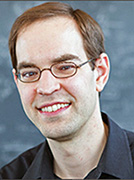Division on Dynamical Astronomy Announces 2017 Awards

Richard Fienberg AAS Solar Eclipse Task Force
The AAS Division on Dynamical Astronomy (DDA) has named the 2017 recipients of its two most coveted annual prizes for work in celestial mechanics, astrometry, geophysics, stellar systems, and galactic and extragalactic dynamics.
Dr. Ortwin Gerhard (Max Planck Institute for Extraterrestrial Physics) will receive the 2017 Dirk Brouwer Award, which recognizes a major contribution to dynamical astronomy, for his achievements in modeling the inner Milky Way galaxy. Gerhard has established himself as the premier authority in this area. To unravel the inner structure of our galaxy, which is obscured by dust and inclined to our line of sight, he and his group have combined multiwavelength data with sophisticated models to build a picture of a barred disk galaxy in which the inner bar is the box/peanut structure visible in infrared surveys. This picture is cosmologically important because it establishes that baryonic matter, not dark matter, is completely dominant in the inner part of our galaxy, which we think is fairly typical of large spirals.
Gerhard’s studies of planetary nebulae in clusters of galaxies led to the first measurements of the motions of the intracluster stars making up the diffuse light in the Virgo and Coma clusters, and therefore to insights into the processes by which such light is produced. He has built scientific groups of international standing, fostering strong and coherent research programs that involve graduate students and postdocs. And he has served the global scientific community as an officer of a division and commission of the International Astronomical Union. [Complete citation and short bio.]
Dr. Daniel Fabrycky (University of Chicago) will receive the inaugural Vera Rubin Early Career Prize for his elegant applications of dynamical astronomy to fundamental puzzles in the physical and orbital properties of multiple stars and extrasolar planets. Fabrycky earned his PhD at Princeton University studying hierarchical stellar systems, in which a close binary is circled by a third star in a much larger orbit. He applied what he learned from these systems to make sense of hot Jupiters in wide binaries, reproducing the observed distribution of orbital misalignments with respect to the host star’s spin.
Fabrycky is widely known for his work on NASA’s Kepler mission, which has discovered more than 500 exoplanetary systems with two or more planets. Every time one of those planets crossed in front of (transited) its host star, Kepler detected a slight dimming of the star. Because of the gravitational interactions between the planets, these transits were not exactly periodic — some came a little early, others a little late. Fabrycky has been a leader in using these variations to determine exoplanets’ masses. He and his colleagues have also played a key role in explaining how planets end up in closely packed and/or resonant orbits, for example, through migration in a gas disk. Fabrycky’s generosity with his time and his ideas, especially with regard to mentoring students and junior colleagues, is exemplary. [Complete citation and short bio.]
Both DDA awards celebrate excellence in scientific research; impact and influence in the field; excellence in teaching and training of students; and outstanding advancement and other support of the field through administration, public service, or engineering. In addition, the newly established Rubin Prize recognizes promise of continued excellence in these areas by an astronomer no more than 10 years beyond receipt of their doctorate.
Gerhard and Fabrycky will receive their prizes and give invited lectures at the 2018 DDA meeting in San Jose, California.



